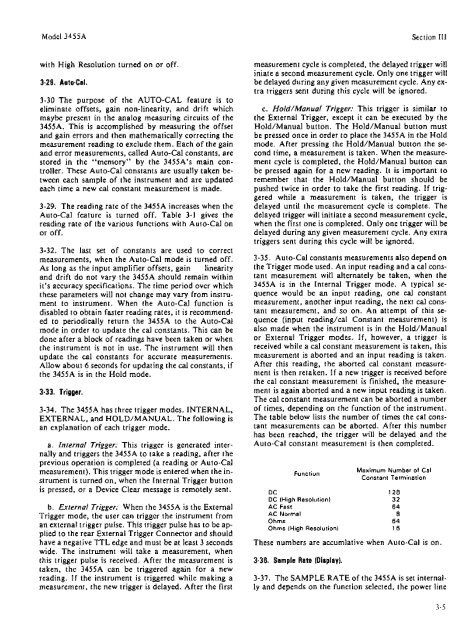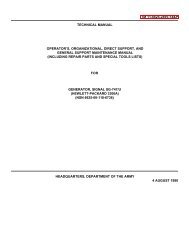Create successful ePaper yourself
Turn your PDF publications into a flip-book with our unique Google optimized e-Paper software.
Model 3455A Section 111<br />
with High Resolution turned on or off.<br />
3-30 The purpose of the AUTO-CAC feature is to<br />
eliminate offsets, gain non-linearity, and drift which<br />
maybe present in the analog measuring circuits of the<br />
345SA. This is accomplished by measuring the offset<br />
and gain errors and then mathematically correcting the<br />
measurement reading to exclude them. Each of the gain<br />
and error measurements, called Auto-CaI constants, are<br />
stored in the "memory" by the 3455A's main con-<br />
troller. These Auto-Cal constants are usually taken be-<br />
tween each sample of the instrument and are updated<br />
each time a new cal constant measurement is made.<br />
3-29. The reading rate of the 3455A increases when the<br />
Auto-Cal feature is turned off. Table 3-1 gives the<br />
reading rate of the various functions with Auto-Cal on<br />
or off,<br />
3-32. The last set of constants are used to correct<br />
measurements, when the Auto-CaI mode is turned off.<br />
As bng as the input amplifier offsets, gain linearity<br />
and drift do not vary the 3455A should remain within<br />
it's accuracy specifications. The time period over which<br />
these parameters will not change may vary from instru-<br />
ment to instrument. When the Auto-Cat function is<br />
disabled to obtain faster reading rates, it is recommend-<br />
ed to periodically return the 3455A to the Auto-Cal<br />
mode in order to update the cal constants. This can be<br />
done after a block of readings hare been taken or when<br />
the instrument is not in use. The instrument will then<br />
update the cal constants for accurate measurements.<br />
Allow about 6 seconds for updaring the cal constants, if<br />
the 3455k is in the Hold mode.<br />
3-34. The 3455A has three trigger modes. INTERNAL,<br />
EXTERNAL, and HOLD/MANUAL. The following is<br />
an explanation of each trigger mode.<br />
a. Inl~rnal Trigger: This trigger is generated inter-<br />
nally and triggers the 3455A to take a reading, after the<br />
previous operation is completed (a reading or Auto-Cal<br />
measurement). This trigger mode is entered when the in-<br />
strument is turned on, when the Internal Trigger button<br />
is pressed, or a Device Clear message is remotely sent.<br />
b. External Trigger: When the 3455A is the External<br />
Trigger mode, the user can triggw the instrument from<br />
an external trigger pulse. This trigger pulse has to be ap-<br />
plied to the rear External Trigger Connector and should<br />
have a negative TTL edge and must be at least 3 seconds<br />
wide. The instrument wilt take a measurement, when<br />
this trigger pulse is received. After the measurement is<br />
taken, the 34S5A can be triggered again for a new<br />
reading. IT the instrument is triggered while making a<br />
measurement, the new trigger is delayed. After the first<br />
measurement cycle is completed, the delayed trigger will<br />
iniate a second measurement cycle. Only one trigger will<br />
be delayed during any given measurement cycle. Any ex-<br />
tra triggers sent during this cycle will be ignored.<br />
c. Hold/Mc~nuc~I Trigger: This trigger is similar to<br />
the External Trigger, except it can be executed by the<br />
Hold/Manual button. The Hold/Manual button must<br />
be pressed once in order to place the 3455A in the Hold<br />
mode. After pressing the HoId/Manual button the second<br />
time, a measurement is taken. When the mtasurement<br />
c ycIe is completed, the Hold/Manual button can<br />
be pressed again for a new reading. Ir is important to<br />
remember that the Hold/Manual button should be<br />
pushed twice in order to take the first reading. If triggered<br />
while a measurement is taken, the trigger is<br />
delayed until the measurement cycle is complete. The<br />
delayed trigger will initiate a second measurement cycle,<br />
when the first one is completed. Only one trigger will be<br />
delayed during any given measurement cycle. Any extra<br />
triggers sent during this cycle will be ignored.<br />
3-35. Auto-CaE constants measurements also depmd on<br />
the Trigger mode used. An input reading and a cal cons-<br />
tant measurement will alternately be taken, when the<br />
3455A is in the Internal Trigger mode. A typica! se-<br />
quence would be an input reading, one cal constant<br />
measurement, another input reading, the next cal cons-<br />
tant measurement, and so on. An attempt of this se-<br />
quence (input reading/cal Constant measurement) is<br />
also made when the instrument is in the Hold/Manual<br />
or External Trigger modes. If, however, a trigger is<br />
received while a cal constant measurement is taken, this<br />
measurement is aborted and an input reading is taken.<br />
After this reading. the aborted cal constant measure-<br />
ment is then retaken. I I a new trigger is received before<br />
the cal constant measurement is finished, the measure-<br />
ment is again aborted and a new input reading is taken.<br />
The cal constant measurement can be aborted a number<br />
of times, depending on the function of the instrument.<br />
The table below lists the number of times the cal cons-<br />
tant measurements can be aborted. After this number<br />
has been reached, the trigger will be delayed and the<br />
Auto-Cal constant measurement is then completed.<br />
Functiun<br />
Maximum Number of CeI<br />
Constant Termination<br />
OC 128<br />
DC {High Resorutionl 32<br />
AC Fast 64<br />
AC Normsl 8<br />
Ohms 64<br />
Ohms (High Resolution) 16<br />
These numbers are aecumlative when Auto-Cal is on.<br />
3-36. Sanyls Rats {Displnyl.<br />
3-37. The SAMPLE RATE of the 345SA is set internal-<br />
ly and depends on the function selected, the power line



